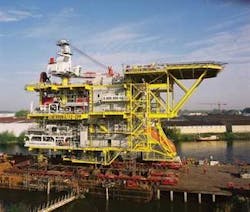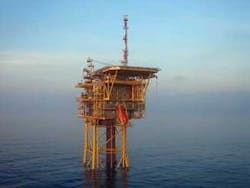Chevron unlocking shallow gas potential in Dutch North Sea
Jeremy Beckman, Editor, Europe
Chevron is taking gas production to the northernmost reaches of the Dutch North Sea. Its A12 project, due onstream by the end of the year, is also the first to harness shallow gas from a cluster of technically demanding discoveries dating to the early 1970s.
These fields extend in a crescent formation across five blocks in the Dutch A and B quadrants. There are no gas production centers in the area. The nearest is Wintershall’s A/6-B/4 in German waters 50 mi (80 km) to the north.
Chevron became operator of the blocks as a result of its merger with Unocal in August 2005. A year earlier, Unocal filed a development plan for the A12a field, shortly after acquiring the interests from the Shell/ExxonMobil joint venture, NAM.
Gerard Schut, general manager for Chevron Exploration and Production Netherlands, was at the helm of Unocal Netherlands when the transaction went through. He just had been re-assigned to The Hague after 10 years in Thailand. At that time, the company’s operated offshore production was modest, derived from five small, declining oilfields and two gasfields nearing depletion,
“Exiting from what we had was not a very lucrative option,” Schut says. “We did, however, see opportunities in numerous discoveries elsewhere on the Dutch shelf. When the A&B blocks came on the market in 2004, the gas price was still low. But we felt Unocal Netherlands had the organizational capability in place internally to develop this area, and to do so at relatively low cost.”
The package acquired from NAM comprised operated interests in two exploration licenses (B10a/A12b and B16a), and five production licenses (A12a, A12d, A18a, A18c, and B13a/B10c), which included five mid-size gas structures.
“The companies that drilled the discovery wells over the years had been targeting deeper horizons,” Schut explains, “and in each case ran into shallow gas, which is normal at subsurface depths of around 400 m (1,312 ft). But eventually, they figured out that these big pancake structures warranted targeting with drillstem tests.”
Despite the potential volumes, development was held back by a variety of technical concerns, notably low reservoir pressure (30-60 bar or 3-6 MPa) and unconsolidated sands. NAM’s most recent attempt was its Neptunus project in 2001, the aim being to cut costs on marginal developments in different parts of the Dutch shelf via look-alike production platforms. In A&B’s case, NAM examined a re-locatable version to produce the various fields in sequence, but the scheme was never executed.
Following a review of the A&B blocks well data and existing 2D seismic, Unocal Netherlands commissioned Gardline to acquire a new, high-resolution 2D shallow seismic survey over one of the larger structures, the A12a field in 2005. This spring, Gardline conducted another survey over the B13 and A18 fields. The data is being interpreted by Chevron geoscientists.
“What we have here is stacked pay in numerous large, but thin pancake structures,” Schut says, “with six different reservoirs in each case, located at subsurface depths of between 350 m and 700 m (1,148 ft-2,297 ft).”
During 2004-05, the conceptual engineering team identified analogies with various Unocal-operated fields in Indonesia and the Gulf of Mexico.
“We screened various concepts,” Schut says, “some similar to NAM’s idea of relocating a platform from one field to another to sustain peak production rates. But our review suggested that the relocatable platform option would leave too much gas unrecovered, as tail-end production from each location would be left in the ground.”
Another option was full-scale development from the outset via a centrally located platform tying in gas from all the fields, including other shallow gas fields owned by other companies, e.g., Wintershall’s relatively recent A15-3 discovery to the south of block A12a. However, uncertainty over reservoir performance prompted a more cautious, phased solution, focusing initially on A12a. This plan was approved by partners Dyas, DSM Energie, and EBN. The Dutch government granted the production licenses in June 2005.
By this point, front-end engineering already was well advanced, and Chevron awarded a letter of intent to Heerema Fabrication Group in the summer of 2005 for detailed design, construction, installation, and hookup of the A12 central production platform (CPP).
“What we are doing is putting in place processing capacity of 130 MMcf/d (3.68 MMcm/d),” Schut explains, “with the facility operating at its full production capability, subject to pipeline capacity. Depending on the reservoir performance and production history over the first few months, we will look to put in place the next field development, and then the next one, assuming development costs are acceptable.”
A18 or B13 should be next in line, with single wellhead platforms exporting their gas to the CPP once A12 is off plateau.
“At this stage, there is still uncertainty in A12’s recoverable gas. Our estimates are fairly wide-ranging because of uncertainty over what reservoir water will do and its effect on recovery. Once it’s in production for a few months, we will be in a position to be more open regarding the next phase of development and timing.”
The company has talked to several fabricators about various options for new platforms. There could be one new installation, or two at one time. “The nice thing with this development program is the opportunity to share logistics. On the other hand, there is a risk of excess production capacity developing two fields simultaneously, the result being that you can’t produce the gas,” Schut says.
The jackupNobleGeorge Sauvageau was due to start development drilling on A12 in August. The current plan calls for seven production wells, all of which should be in place by the end of October. “These are shallow wells that should not take long to drill,” says Chevron’s projects manager Stuart Klein, “but we want to make sure we have enough time to manage the completions.
“We have the option to put some of the wells onstream before drilling is complete,” he adds. “We are evaluating simultaneous drilling and production as an alternative, which would allow us to start up before the last well is completed.”
Chevron Upstream Europe in Aberdeen handled the well design and engineering. A12a will be produced using a combination of single reservoir wells with horizontal sections completed in the larger layers, and deviated wells intersecting the thinner layers, all designed for commingled production. The wells and completions also are equipped with proprietary sand exclusion technology to counter ingress from the unconsolidated fine-grained sands.
In late May, Heerema Marine Contractors’ heavy-lift vesselHermod installed the 2,800-metric-ton (3,086-ton) deck, built by Heerema Fabrication Group in Zwijndrecht, on the 12-slot, 1,200-metric-ton (1,323-ton) jacket, fabricated down the coast in Vlissingen.
“The location is pretty much central on the A12 field,” says Schut. “This is a conventional, four-legged platform in 30 m (98 ft) water depth, designed to process high-quality gas, which is 99.8% methane. But it needs a lot of horsepower to compress the gas - in some parts of the field three-stage compression will be required from the outset to get gas into the pipeline.”
This will be provided via:
- One Solar Centaur 70 (7 MW) two-stage centrifugal main compressor
- One E-motor driven Ariel booster compressor (900 KW), with variable-speed drive
- One dual-fuel, radial 2 MW gas turbine-driven generator provided by Opra, located in Hengelo
- One 400 KW backup diesel engine generator, supplied by Zwart Techniek IJmuiden.
The 55 x 38 x 26 m (180 x 125 x 85 ft) topsides include modules for gas/water/sand separation and gas drying. The deck is equipped with one 30-ton (27-metric-ton) capacity Liebherr crane, and living quarters for 26 people, although the regular crew will only be nine-strong (seven for operations and maintenance, two for catering). Beds might fill up, however, if events call for workovers or large-scale maintenance.
Heerema Zwijndrecht had prior knowledge of the complexities of this project, having participated in NAM’s Neptunus bidding round. According to Koos Herweijer, Heerema Zwijndrecht commercial manager, “We also had knowledge, built up over 30 years’ experience in the North Sea, of what we consider the optimum generic gas processing system. We were able to apply this on A12.
“The main issues for us were potential sand production and the fact that compression is needed from day one. Normally, compression capacity this size is added after six to seven years of production. Otherwise, this is very much a standardized North Sea platform from our point of view, in some ways not unlike an unmanned installation. It has been engineered to functional specifications drafted by Chevron, and also has been designed for tie-in of third-party or other Chevron fields, via wellhead-type platforms.
“One of our advantages is that as part of the Heerema group, we can cover the full scope of a gas field development. We have a lot of in-house experience on how to engineer, build, and install, so in this case, we were able to optimize fabrication of the topsides and jacket to make construction and installation easier.”
Hookup operations were completed in 10 days.
“We decided we would do the offshore phase without an accommodation rig as utilities on the integrated topsides were fully commissioned onshore. There was a certain level of risk in this approach, so operations had to be planned carefully and required the platform to leave the yard with minimal outstanding construction items to complete. This approach, including stringent planning of the completion and testing of all systems onshore, is proving to be very successful also on the A12 project.”
In June Allseas’Lorelay installed the 17-km (10.5-mi), 16-in. (40.6-cm) pipeline connecting A12 output to the A6-F3 gas transportation pipeline, with tie-ins completed by divers in July. A6-F3 itself ties in to the Nogat trunkline, which terminates at Den Helder. Chevron also considered putting in an 85-km (53-mi) line linked directly to Nogat, but was dissuaded by pipelay costs.
Either option involves paying tariffs to existing pipeline owners. Once in the Nogat system, the gas will be mingled with supplies from F3 and L9, and also Danish fields.
“The buyer should be happy to have our gas, as its methane content is so high and it will blend well with existing gas streams,” says Schut.
The total budget for the development is $200 million.
“Everything is on schedule,” Schut says, “and we expect first gas at the end of the year. Getting to peak rates will depend on available capacity in the Nogat trunkline. Initially, there will be constraints. However, some time in the future, as A12 starts to deplete, capacity will increase. We expect the biggest field to produce for 10-12 years, others a little less.”
Klein says: “We have set up A12 so we can accommodate future entries of gas from other fields, like our own B13 and A18 fields. Other operators also can use it to develop their fields, or leave us to do it on their behalf.” There is also space on the top deck for extra equipment. “We plan to add further compression at a later stage for satellite developments.”
“Chevron is looking forward to seeing the new A12 infrastructure becoming an enabler for several more field developments in the wider AB area, whether Chevron develops such fields or others do.” Schut speculates: “Further exploration into expanding the shallow gas play, will largely depend on our success. Shallow gas has traditionally not been a focus for operators on the Dutch shelf as it is seen as technically challenging, so we realize that all eyes are on us.”





